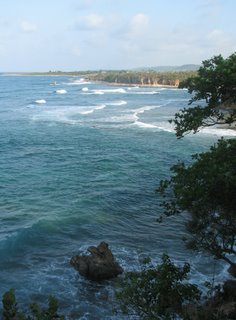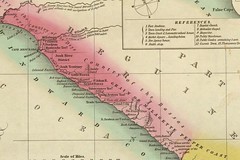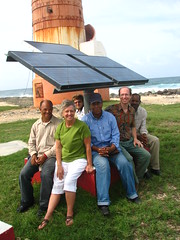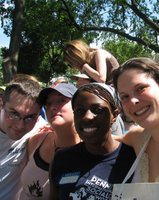Hello friends and family! I am pleased to offer the following report from our first week in Jamaica. As time allows I will be adding eye candy.
Monday, May 15, 2006 - From Philadelphia to Yallahs.
- Arrive in the Norman Manley International Airport, Kingston
- Stop at the Harbor View Centre for bank machine and Tastee Patties
- We were welcomed by news that Yallahs has been largely devoid of rain this year. We were instantly assailed by afternoon heat, remembering that we had left behind cool weather and rain in Philadelphia that morning. Driving east from Kingston, we peared out at a parched and dry southern Jamaican coast. The village of Yallahs is located between the Yallahs River and the two large salt ponds. Both of these bodies of water had dried up, revealing bare and dusty river and lake beds. Once we arrived at the Center for Global Understanding (Carleva Bay) it didn’t take long to change into our swimsuits and cool off at the beach.
- We also enjoyed our first meal of wholesome Jamaica food, prepared by Jay and Sophia Grant. Since we have four vegetarians (out of eight students) on the trip, we are enjoying fresh tropical fruits and vegetables in abundance.
- Watch this space for the first batch of photos, IMG_0946 to IMG_0969
Tuesday, May 16, 2006 - Touring Yallahs and Morant Bay.- Visit to Yallahs Basic School and discussion with Mrs. Grant.
- Drove past Duhaney Pen.
- Arrival for the first time in Morant Bay – Orientation at the Women’s Centre.
- Drive out to Rocky Point.
- Sunset from the road.
- IMG_0970 to IMG_1032
Wednesday, May 17, 2006 - First full day at service sites. 
- Wake up early and go for a walk out along the salt pond and back along the beach with Kingsley Keith (foreground), Anne, Jillian, Hazel.
- Cheraine and Mike accompany Anne and Casey to Yallahs Basic School.
- Mike gets in trouble for wandering away to take pictures at the regional school event at the Baptist Church across the street.
- Visit to Yallahs Branch of Public Library. Taxis into Morant Bay. Juicy Patties and Sim Cards for Anne and Mike’s phones.
- Was Mike too mean towards the taxi drivers? We are each able to ride back for 50 J. Depending on who you ask, the tyical fare for a route tax bus is 60 or 70 Jamaican Dollars
- Matthew and Jillian travel to Seaforth with representative from RADA.
- Ciarra, Hazel and Christianne spend the day teaching at the Women’s Center.
- IMG_1042 to MVI_1199
Thursday, May 18, 2006 - Second day at the service sites.- Anne and Casey to Yallahs Basic School, where they have a planning discussion with Mrs. Grant. Route taxi van driver is mean to them.
- Jillian, Matthew and Cheraine are dropped at RADA; their supervisor left for the field at 9:00 am, so they hitch a taxi home.
- Women’s Center group, Hazel, Christianne and Ciarra, find themselves teaching again.
- Evening walk, Mike shoots his first videos. Mike gets in trouble for separating from the group off the beach-walkers, prefering to take the back route along the road, where he shoots more videos
- Students lead discussion of the first book: Anne Kopena on the report from the World Bank.
Friday, May 19, 2006 - Rain Day. 
- This wound up being a lazy day. We were to take an excursion, but Mr. Garnet doesn’t arrive until 4:00 pm.
- Students entertain themselves pretty much all afternoon at Carleva Bay.
- No pictures.
Saturday, May 20, 2006 - Kingston Day.
- Since Mike doesn’t have a map, we meet up with Kingsley Keith, Nelson's brother who lives in Kingston. He guides us past Tuff Gong down to the Industrial Zone and finally the Craft Market. - Several hours spent at the National Gallery of Jamaica. Shown is a right-hand panel of the work by artist Christopher Clave called 'Blackboard #20.' Once you get a look at the entire work, you will realize that it depicts the souls of black people swimming like a school of fish - a metaphorical treatment of the middle passage.
- Fiasco of trying to find a vegetarian restaurant in Kingston as everyone is hungry from missing lunch. Eve Restaurant is closed because the owners are Seventh Day Adventists.
Sunday, May 21, 2006 - Recreation Day.

- Christianne and Casey leave at 7:00 am to accompany Jay on a trip with his middle school students to an all-inclusive resort on the way to Montego Bay.
- The other group travels with Garnet to Portland. First destination is Reach Falls, officially closed but then reopened by the guide (who has to be paid to bribe security to the looking the other way). Nelson demonstrates masterful skills of negotiation, resorting to the patois and gets the group in for 800 J.
- At the falls, Mike walks downstream while Anne and Cheraine walk upstream.
- Another group of Americans arrive. How much per head – 200 J?
- On the way out the group purchases woodwork and blow toys.
- We continue along the coast to Long Bay, which is also very relaxing.
- In the end, everyone reports having a good day.
Monday, May 22, 2006 - Site Day.
- 6:00 am walk down the beach with other students: Nelson, Anne, Jillian, etc. Watching the fishermen pulling the nets.
- The Morant Bay volunteers leave earlier this morning so that Matthew, Ciarra and Jillian can hook up with their supervisor for the day. They end up having a full day in the field.
- Christianne, Hazel and Casey have what they describe as a slow morning at the Women’s Centre. At noon they lave with some of the girls and get an interesting tour of Morant Bay. Ciarra buys a lot of food!
- Anne and Casey stay at Carleva Bay for the day since their basic school isn’t holding classes Monday. They wind up spending a good portion of the day playing with Renaldo, a young man who lives next door with his father, and Hyacinth’s daughter.
- Mike talks with Carol Marfisi by phone and tries to get office work done; writes letter of recommendation for Penny Richards; corresponds with folks at church.
- Evening walk along the salt pond with Hazel and Anne; exercises and painted sky.
Tuesday, May 23, 2006 - Jamaican Labor Day.
- Mike wakes at 4:00 am, to find other students already awake in their rooms.
- Rainstorm at 5:00 am.
- Labor Day in Jamaica is like Phila's Martin Luther King Day of Service.
- Two students volunteer at Jay Grant's church, where members of the community are painting and picking up trash.
- Mike spent time posting stories and photos to the
Flickr site and Edu-Tourism blog.
- Novella and Mike discussed standards for student assessment. We will be collecting and commenting on student journals this week.
- This evening student presentations continue, with Hazel Carrera helping us to get to know Nancy Lopez's book
Hopeful Girls, Troubled Boys (Routledge, 2003).
- Mike is charged with the task of writing a sample critical reflection paper, that can be used as a model for students as they begin to consider the topic for theirs.










